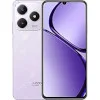Unisoc Tiger T612

Unisoc Tiger T612: A Budget Processor for Everyday Tasks
April 2025
In the world of mobile technology, the balance between price and performance remains a key factor when choosing a smartphone. The Unisoc Tiger T612 is one of those processors that proves you can still achieve a respectable user experience in the budget segment. Let's explore what makes this system-on-chip (SoC) noteworthy, who it is suitable for, and what tasks it can handle.
Architecture and Technology Process: Foundations of Efficiency
The Unisoc Tiger T612 is built on a 12-nanometer process technology. Although this technology is no longer considered cutting-edge (compared to 6nm and 4nm chips), it provides acceptable energy efficiency for its tasks.
CPU: 8 Cores for Multitasking
The processor employs a hybrid architecture with eight cores:
- 2 Cortex-A75 cores at a frequency of 1.8 GHz — for resource-intensive tasks.
- 6 Cortex-A55 cores at a frequency of 1.6 GHz — for background processes.
This division allows for optimized power consumption: the powerful cores are activated during gaming or photo editing, while the energy-efficient ones are used during surfing or listening to music.
GPU: Mali-G57 MP1 — Modest Graphics
The Mali-G57 MP1 GPU with a single processing unit (MP1) is a solution for basic gaming. It supports Vulkan 1.1 and OpenGL ES 3.2 APIs, allowing it to run most mobile games, albeit at low or medium settings.
Technological Features:
- Support for displays with resolutions up to Full HD+ (1080 × 2520 pixels).
- Ability to work with cameras up to 64 MP.
- Hardware decoding of 4K video at 30fps.
Real-World Performance: What Can the Tiger T612 Do?
Gaming
With the Mali-G57 MP1, the processor can handle less demanding titles such as Among Us, Candy Crush Saga, or Clash Royale at medium settings. However, for heavy games (like Genshin Impact or Call of Duty: Mobile), you will have to reduce the graphics to a minimum and accept a frame rate of around 25-30 FPS.
Tip: For comfortable gaming, choose smartphones with the Tiger T612 that are equipped with a liquid cooling system or at least a passive heat sink.
Multimedia
The chip is well-suited for everyday use:
- Smooth scrolling on social media and in browsers.
- 4K video playback (with recording limited to 1080p).
- The ability to handle 3-5 applications running in the background (with 4-6 GB of RAM).
Artificial Intelligence
The Tiger T612 does not have a dedicated neural processing unit (NPU), so AI tasks (like photo enhancement or voice assistants) are performed using the CPU and GPU. This increases power consumption and slows down processing. For example, applying a filter in an app like Adobe Lightroom will take 2-3 seconds instead of 1 second on chips with an NPU.
Power Consumption and Heating
The 12nm architecture isn't the most energy-efficient, but in devices with a 5000 mAh battery, a smartphone with the Tiger T612 can easily last a day with moderate use. Heating rarely exceeds 40°C even during gaming, making the system stable, although not ideal for extended sessions.
Integrated Modules: Connectivity and Communication
The Unisoc Tiger T612 is targeted at the budget 4G device market:
- 4G LTE Cat-7 modem — download speeds up to 300 Mbps, upload speeds up to 100 Mbps.
- Wi-Fi 5 (802.11ac) — stable operation on 5 GHz networks.
- Bluetooth 5.0 — for connecting headphones and fitness trackers.
- Navigation: GPS, GLONASS, BeiDou — quick location determination.
What’s Missing:
- No 5G support — a downside for the future, but 4G still dominates the budget segment in 2025.
- Wi-Fi 6 and Bluetooth 5.2 — these modules are available in more expensive chips.
Comparison with Competitors: Who's Stronger?
Unisoc Tiger T612 vs MediaTek Helio G85
- Helio G85 (12nm) — the main competitor in the same price range.
- Geekbench 6 Single Core: 410 (T612 wins).
- GPU: Mali-G52 MC2 — slightly better in gaming.
- Camera support: up to 48 MP versus 64 MP for Tiger T612.
Conclusion: The T612 is preferable for photography, while the Helio G85 is better for gaming.
Unisoc Tiger T612 vs Qualcomm Snapdragon 680
- Snapdragon 680 (6nm) — newer technology process, but higher price.
- Better energy efficiency.
- AnTuTu 10: ~280,000 points compared to 242,301 for T612.
- GPU Adreno 610 — comparable to Mali-G57 MP1.
Conclusion: Snapdragon 680 wins in battery life, but devices based on it are $20-30 more expensive.
Use Cases: Where Will the Tiger T612 Shine?
Everyday Tasks
- Social media, messaging, browsing.
- Streaming video (YouTube, Netflix).
- Working with office applications (Google Docs, Excel).
Photography and Videography
- Support for cameras up to 64 MP allows for detailed shots in good lighting.
- Nighttime photos will be noisy — no advanced ISP (image signal processing).
- Video recording: maximum 1080p at 30fps.
Gaming
- Suitable for casual games and retro projects.
- For game streaming (Xbox Cloud, GeForce Now) a stable Wi-Fi connection is required.
Pros and Cons of the Processor
Pros:
- Low cost of devices ($100-200).
- Support for modern communication standards (4G, Wi-Fi 5).
- Adequate performance for basic tasks.
Cons:
- No 5G support.
- Weak GPU for demanding games.
- Outdated 12nm technology process.
Practical Tips: How to Choose a Smartphone with the Tiger T612?
1. RAM: At least 4 GB (better 6 GB for multitasking).
2. Battery: Starting from 5000 mAh — compensates for the power consumption of the 12nm chip.
3. Cooling: Look for models with graphite or copper heat sinks.
4. Android Version: Preference for devices with Android 14 and a promise of an upgrade to Android 15.
Examples of smartphones in 2025:
- Tecno Spark 11 Pro ($130): 6.7" HD+ screen, 8 GB of RAM, 128 GB of storage.
- Infinix Smart 8 ($150): 5000 mAh battery, 50 MP camera, NFC.
Final Conclusion: Who is the Tiger T612 Suitable For?
This processor is designed for those looking for an inexpensive smartphone ($100-200) without frills. It is ideal for:
- Students — studying, social networking, music.
- Older users — simplicity, long battery life.
- Backup devices — reliable performance for basic scenarios.
Main Benefits:
- Price lower than competitors with equivalent performance.
- Support for modern communication standards.
- Stability in everyday tasks.
The Unisoc Tiger T612 is proof that budget chips can be practical. While it may not impress with speed, it certainly won’t disappoint those who value the balance between price and quality.
Basic
6x 1.8 GHz – Cortex-A55
GPU Specifications
Connectivity
Memory Specifications
Miscellaneous
Benchmarks
Phones with Tiger T612



Comparison of Devices with Tiger T612
Compared to Other SoC
Related SoC Comparisons
Share in social media
Or Link To Us
<a href="https://cputronic.com/soc/unisoc-tiger-t612" target="_blank">Unisoc Tiger T612</a>

